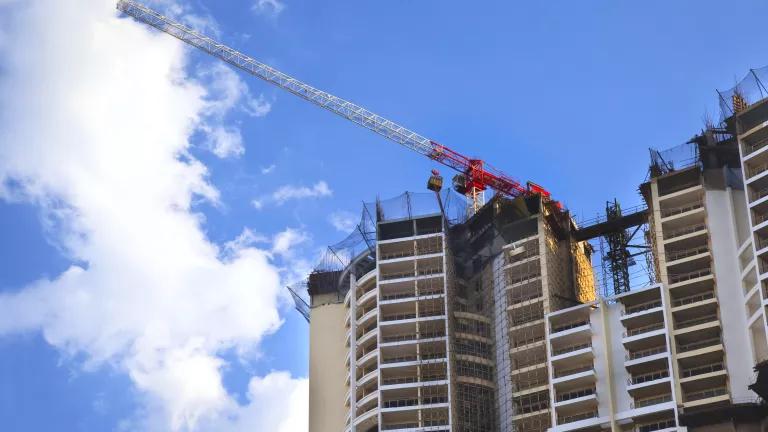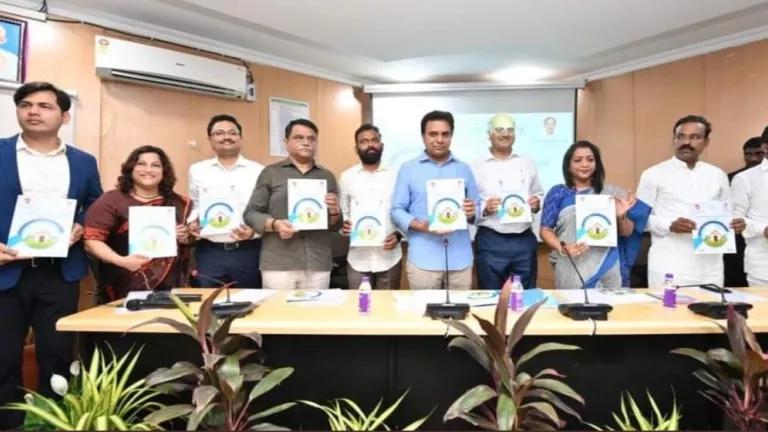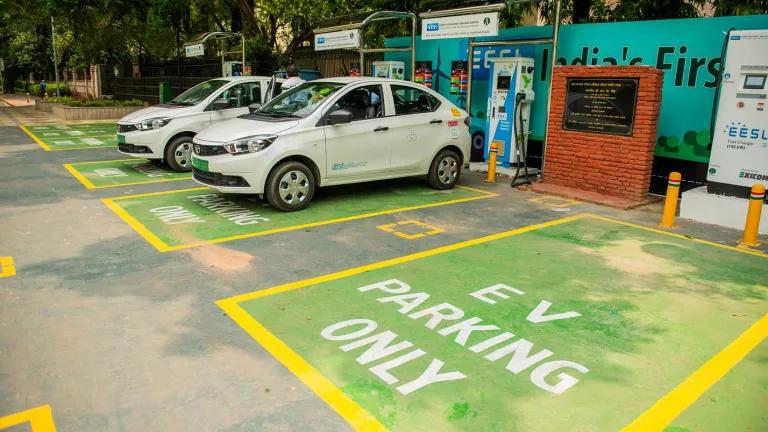Tata Consultancy Services, one of India’s biggest IT firms, recently built a five-million-square-foot campus for 24,000 employees outside the southern city of Chennai. Its competitor, Infosys, is adding 10 million square feet of custom-built office space. Several major universities, including the prestigious Indian Institute of Technology, have recently opened new campuses in the relative backwaters of Patna, Bihar--and the government plans to build nearly 400 more new colleges, from the ground up, over the next five years. Fourteen skyscrapers are under construction in India, and real estate developers, thanks to a recent vote in Parliament favoring the entry of foreign retailers, are now predicting a rise in demand for commercial retail space.

Construction in Greater Noida, outside Delhi, India.
Credit: Bhaskar Deol
These new office buildings, malls, and universities are just the cusp of India’s building boom. An estimated two-thirds of the commercial and high-rise residential structures that will be standing in India in 2030 have yet to be built. That puts India at a critical juncture as it seeks new ways to power its growing economy, and resolve its existing, chronic energy shortages. Buildings already consume 30 percent of India’s energy. These new buildings and their tenants, with their lights, air conditioners, refrigerators, water heaters, washing machines and entertainment systems--could continue to suck the life out of India’s feeble energy grid. Or they could dramatically reduce energy waste and become part of India’s most promising solution for closing its energy gap--efficiency.
The widespread blackouts of July 2012, which left 680 million people—more than twice the population of the United States—without power, revealed the severity of the country’s energy crisis. The Indian government is looking for answers everywhere, planning hundreds of new coal-fired power plants, hydroelectric dams, and expanding solar power and other renewable energy sources. But the cheapest, cleanest, and fastest way for India to bring power to people who need it is energy efficiency. According to McKinsey & Company, India can save $42 billion every year just by reducing energy waste in buildings.
At the recent U.S.-India Energy Partnership Summit in Washington, D.C., I discussed opportunities to drive energy efficiency in India with efficiency experts, business leaders and government officials from both nations. NRDC has been working on energy efficiency for decades in the United States, and more recently on the ground with local partners in China, India, and Latin America.
Energy efficiency isn’t just about cost savings. It helps reduce energy waste, which means more people can get energy when they need it—which translates to less food wasted from spoilage, more productivity in offices and factories, trains able to run on time. Energy efficiency eliminates the need for new power plant construction, cuts global warming pollution, and in India, dramatically reduces air pollution, since many large buildings use backup generators that run on dirty diesel fuel. It also saves money for consumers and businesses. In the United States, efficiency standards for appliances will cut electricity use by 14 percent and save consumers more than a trillion dollars in energy costs by 2035. California’s latest building energy codes will knock out the need for 6 new power plants, while saving tenants and building owners billions of dollars in energy costs over the next 30 years.
We’ve had great success in helping cities design smart policies to break down market barriers to energy efficient building retrofits. In New York, NRDC helped craft the city’s breakthrough Greener, Greater Buildings Plan, which requires large privately owned buildings—which comprise nearly half the city’s square footage—to measure and report their energy use every year, just as they would property tax. It helps owners get financing for energy-saving measures and makes government buildings become more efficient. The plan will save New York City $700 million each year in energy costs, cut carbon pollution by 5 percent, and create about 17,000 jobs. We’re working to design similar programs in ten other cities.
But even more economical than retrofitting existing buildings is to make them more efficient in the first place, incorporating the most energy efficient windows, lighting, and air-conditioning systems at the design stage, before the building goes up. India has a tremendous, not-to-be-missed opportunity to lock in energy savings for the next few decades, right now. Today, Indian buildings account for about 30 percent of energy consumption, compared to 40 percent in the United States--but the vast majority of Indian building stock isn’t on the ground yet. India’s building-occupied area will skyrocket from 8 billion square meters in 2005 to 41 billion square meters in 2030, presenting an enormous opportunity to implement efficiency measures and trim waste.
India already has a voluntary energy conservation building code, and several state governments plan to make these building energy standards mandatory for new commercial construction in the next two years. NRDC is working with state governments, including that of Andhra Pradesh, home of the high-tech hub Hyderabad, where I visited in 2011, to share best practices on achieving compliance, including educating builders as well as building authorities, and developing a multi-stage rollout process for the standards.
We’re also working with business leaders in India to make the business case for efficiency. After all, reducing waste is smart business. Last month, during NRDC’s President Frances Beinecke’s visit to India, we released a landmark case study, together with our partner, the Administrative Staff College of India, on the Godrej Bhavan building in Mumbai. This is an iconic building that houses the top management of Godrej and Boyce, a leading Indian industrial corporation. In 2010, the building underwent a $100,000 retrofit, a relatively small investment that has already proved its worth. Our analysis showed that in just two years, the building’s electricity costs have fallen nearly 30 percent. Godrej is on track to recoup the cost of investment in less than 5 years.
Demonstrating the profitability of energy-efficiency measures is one key to driving change in the private sector, anywhere in the world. And smart government policies, on all levels, as we’ve found at home and abroad, can also help promote efficiency and reduce energy waste.
Energy efficiency is one of the world’s largest energy resources, and we are only just beginning to tap its potential. India has a tremendous opportunity to turn its building boom into an energy boom, simply by building in energy-efficient features and capturing the value of energy savings in its buildings.



